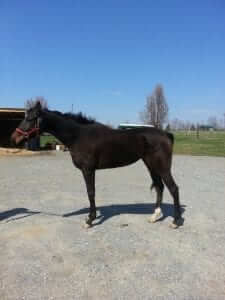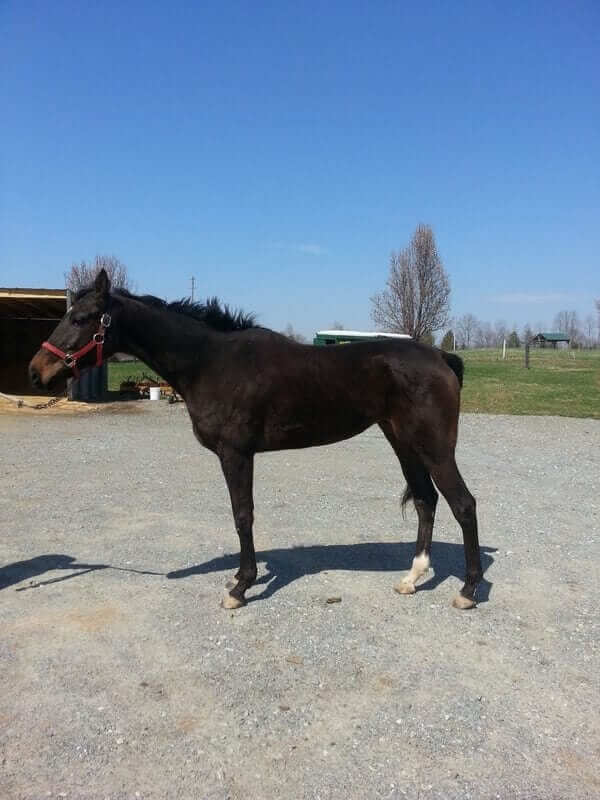The easy keeper horse is unique in more ways than one. Not only are they more prone to metabolic syndrome and insulin resistance, but lameness conditions also seem to be more prevalent. Most horse owners know what this term means almost instantaneously when they hear it. In general terms, it refers to a horse that has a tendency to carry more weight and gain weight easily, often with just the sight of a green pasture. Almost any horse can be an easy keeper, but there are certain breeds that are more prone including Quarter Horses, Pony breeds, draft breeds and even some warmbloods. Aside from metabolic conditions, many horses tend to have concurrent lameness issues ranging from joint degeneration to tendon issues and laminitis, but also many also seemed more prone to allergies, respiratory problems and even eye issues. What is the connection and why do many standard therapies fail to provide relief for this particular group of horses?
All horses tend to be susceptible to joint degeneration, tendon injury, laminitis, allergies and even foot soreness/thin soles, but the easy keeper tends to be different in their response to these injuries with often delayed healing and recovery. In some situations, such as laminitis, the easy keeper is more the norm when we really evaluate those patients. More often than not, we may have two horses present with the same condition, let’s say a tendon injury, but the two horses differ in the body build. One may be a normal, lean, hard keeper or well developed horse while the other may be deemed an easy keeper with more fat accumlation and stockier build. If we approach them the same in regards to therapy, often we get very different results.
Staying on the condition of a tendon injury, using traditional therapies including NSAID medications, rest, topical therapies and even stem cell treatments often tend to bring more satisfactory results in the normal or well conditioned horse as compared to the easy keeper. This may not be true in all situations, but in my experience over the years, the easy keeper has tended to pose more of a challenge in regards to maintaining long term results. Again, the question is why?
Inflammation, as discussed before in several articles, is responsible for most cellular changes and tissue deterioration, not to mention pain. It is this uncontrolled inflammatory response that becomes heightened, leading to pathology ranging from insulin resistance to joint deterioration, laminitis and even allergies. In a normal horse of normal body condition with a joint or tendon injury, inflammation is present but its origin is often one of stress, overexertion and possibly diet. In an easy keeper, there is inflammation present but its origin is of several locations, often centering in the gut or gastrointestinal tract.
Gut Origin of Metabolic Syndrome and Lameness in the Easy Keeper Horse
We have defined the ‘easy keeper’ as a horse that has a tendency to gain weight easily or is more stocky than average. I am going to broaden this definition to include those horses thar are ’rounder’ or stockier, but seem to have the tendency to internalize their emotions, holding them inside. When emotions are more internalized, there is more of a tendency to create gastrointestinal issues, which can then become the point of origin for problems. This is stated in comparison to those horses that exert or display their emotions or energy outwards, being more difficult to manage or hyper-active at times. They too can have gastrointestinal problems, but it is often secondary and needs a different approach to therapy.
Let’s look at these two horses, both Thoroughbreds and traditionally thought to be ‘hard keepers’, but it is not always true. Here we have one that is more lean or actually thin by genetics (LEFT) and another that has a stockier type of build (RIGHT). Both horses had tendon injuries and poor foot growth, but were managed differently with results obtained in both situations. If we applied the same approach to both horses, likely one would do well while the other likely not.


When we think of a person or animal as being ‘overweight’, often the first body system that comes to mind is the ‘gut’, or at least in my mind it does. The intestinal tract is often the center of focus in the easy keeper or stockier horse and in several research studies, conditions including leaky gut syndrome, IBS and IBD have all been implicated as a result of localized inflammation within the bowel lining leading to a breakdown in the normal bowel barrier. When this barrier is compromised due to inflammation, then food particles, bacteria, dyes and other potentially toxic debris from the diet can gain access to the body and bloodstream, resulting in a heightened immune response, which then triggers a heightened inflammatory response. This increased inflammatory response then feeds out to the rest of the body, predisposing to joint damage, tendon injury, allergies and a host of other conditions. The gut then becomes the primary source of inflammation in these particular horses, leading to cellular changes at a systemic or whole horse level. Given that the immune response is based out of the gut, we then potentially trigger immune system problems including predisposition to infections and allergies ranging from a skin level to the respiratory tract. Seeing the gut as the ‘source’ of the problem, it then makes sense to target it during therapy. We also have to realize that if the gut is compromised due to inflammation, then the ability to digest and absorb nutrients is also impaired, contributing to tissue weakness, hoof problems and hair/coat issues, often despite a healthy diet.
Seeing the Big Picture on the Easy Keeper Horse and Lameness
When faced with a lameness or health crisis, practically of any origin, we must first ask what type of horse, regardless of breed, are we dealing with; easy keeper or non-easy keeper? Now in some cases, the breed IS a dead giveaway as I almost always think “gut” in ponies, draft breeds and most quarter horses. This also holds true for some disciplines, such as dressage, as I think the stresses associated with that particular discipline predispose to more ‘gut’ oriented horses being easy keepers or stockier. The way we approach each of these can make all of the difference as our goal is to manage inflammation and promote cellular health, but do we need a more targeted approach for the easy keeper specifically? The answer to this is ‘YES’, but with the goal of managing inflammation not only a systemic level but also at the gut level, which can make all of the difference as this is often the source of the problem.
In many cases of tendon injury, joint problems or even laminitis, we tend to focus just on that problem and applying what we know in regards to therapy. If we dig a little deeper into some of these cases, probing for past history, we may find subtle clues that maybe the gut is involved including being an easy keeper, termed a metabolic horse, insulin resistance, gas or digestive issues, cribbing, poor hair coat, poor hoof growth or condition and even sometimes gastric ulcers, although that is not always inferent to gut issues. If we see or find any of these clues, no matter how trivial we think they are and address it for what it is, then the results will often follow above and beyond our traditional approaches.
We have to remember that the gut, if compromised, can contribute heavily to systemic inflammation which can then impact any part of the body from the joints to tendons to the eyes. In addition, if the gut barrier is compromised, immune function can likewise be dysfunctional, contributing to immune problems and allergies. If digestion is impacted sufficiently, then nutrients found in the normal diet may not be properly digested and assimilated, which can technically lead to perceived deficiencies, poor cellular health and even tissue weakness such as poor hoof, hair coat and even tendon health.
Bottom Line on Lameness in the Metabolic Syndrome Horse
All of this information may be somewhat confusing or even overwhelming, but the bottom line is that if you, as a horse owner, trainer or rider, are continuing to have health or lameness issues with your horse, then you need to determine the origin of the problem, looking past the obvious point of injury or illness. One of the first questions you need to ask is, “is my horse an easy keeper or stockier build with more internalized issues?” By determining the answer, no matter what the original problem is, it will help to guide you as to the right course of action. Every horse, easy keeper or non-easy keeper, can display problems such as joint pain, tendon injury, allergies, gastric ulcers or even behavioral problems, but the best course of action will vary between those horses. Even in the case of a behavioral problem such as cribbing, the underlying cause for that behavior is often very different and thus therapy will vary. Infectious conditions including EPM and Lyme fall into this category as well, where we horses of both categories falling victim to these illnesses. If we approach all the cases the same, the results are less than favorable, but if we approach them from a different standpoint, focusing on the origin of the immune problem, then results are improved.
Some conditions are actually more likely to develop in the ‘easy keeper’ horse if we actually sit back and look at it. Consider laminitis for instance. Over 90% of the primary laminitic horses I have seen in 19 years of equine practice are easy keepers or stockier builds. This does not include those horses that develop laminitis secondary to another lameness issue or toxemia associated with colic. The same holds true for most cases of chronic allergies, COPD and even the majority of uveitis horses. Its true when you really think about it. Most uveitis cases are Appaloosa, Paint or QH breeds which all tend to be more stocky and carry more weight. Coincidence? Likely not in my opinion but more so an indicator as to the source of the issue or predisposition.
If we determine that we have an ‘easy keeper’ or more stocky horse with internalized problems, then more often than not, the problem stems from the gut and it is an inflammatory problem or response, so we need to address that issue. So…how do we address inflammation and gut issues at the same time?
My traditional approach with these horses is the use of our EQ Total Support formula. This product was originally researched and studied to target horses with allergies and COPD/RAO health issues. We knew those particular horses had underlying gut problems which were fueling systemic inflammation, allergies and even discharges such as phlegm or mucous. We also made the observation over the many years that most of the allergy horses or COPD patients were actually easy keepers. It was rare to have a lean horse present with those conditions in our experience. What became obvious as time went by and we studied further was that this definition or categorization of horses went beyond just allergies or COPD, but included those with tendon injuries, laminitis, joint problems and even immune issues. We realized that if we took these ‘easy keeper’ horses and addressed the gut with our EQ Total, reducing inflammation and improving gut health, they just seemed to do better than if we just applied our other Cur-OST anti-inflammatory formulas.
The EQ Total Support helps to manage a health systemic inflammation response with the use of Curcumin, Boswellia, Dandelion, Parsley and many other antioxidants and herbs. They are all connected to inflammation and aid in promoting a healthier response. The GI targeting effect comes from Dandelion, Marshmallow and Parsley, all of which reduce inflammation but have specific benefits to the gut and intestinal lining. Dandelion helps to detoxify and reduce inflammation, but also is a great source of Inulin, which is a potent pre-biotic and aids in restablishing normal gut bacterial levels. Marshmallow reduces inflammation but also soothes ulcers and inflamed areas. Parsley provides potent antioxidant properties but also has been used for centuries for its digestive capabilities. We use the EQ Total Support in all cases regardless of main health or lameness problem. In some instances, we will add in another formula in addition to aid in further immune support (EQ Immune) or provide nutrients to aid in tissue recovery (EQ Nourish). Keep in mind that some of these horses look very much overweight and ‘well nourished’ but in fact, they are deficient in nutrients as evidenced by poor hair coat, dandruff, tendon weakness, exercise intolerance, muscular weakness and dry/brittle hooves with decreased growth. This is not always reflective of a poor diet, but more so reflective of an inflamed status within the gut and lack of proper nutrient digestion and absorption.
What we found over the years is that if we take this additional step to promote gut health and reduce inflammation there, then the results for the patient were improved. The gut is the center of many activities in the body and many horse owners try their best to support that region, which is good. The ultimate reality is that often those therapies, including probiotics, other ‘gut oriented’ supplements and even anti-ulcer medications only help in certain situations or are actually bandaids, which is likely due to their lack of ability to target the inflammation but more so just replacing what is being lost or deficient in that area as a result of the inflammation, such as bacteria, or buffering excess acid production. They are rarely actually ‘fixing’ the problem. If we really think about it, if a horse is actually deficient of bacteria in the gut or out of balance, there has to be a reason. If we don’t correct that reason or cause, then simply supplementing them makes no sense as likely our efforts will fail. A discussion on pre-biotics and probiotics is in order, but set for a different article.
There is no ‘cure’ for these horses and their health or lameness issues, regardless of the chosen route of therapy. However, if we approach the problem at its root origins, then our chances of success in regards to managment become much easier and more successful for the long term. Once stabilized, then the therapies are continued on a maintenance basis to help keep things under control.
I hope this helps. It is an important topic and one that can make all of the difference between success and failure. Take a good look at your horse and think outside of the box, seeing things for what they are and seeing the big picture.
All my best,
Tom Schell, D.V.M.
Nouvelle Research, Inc.
tschelldvm@gmail.com


